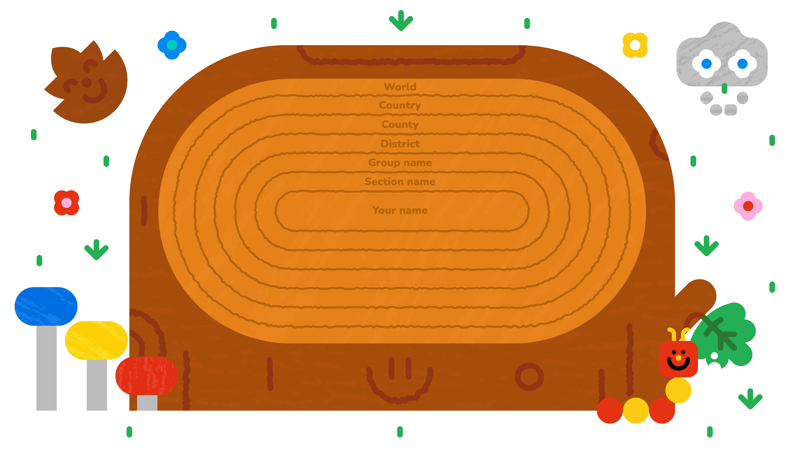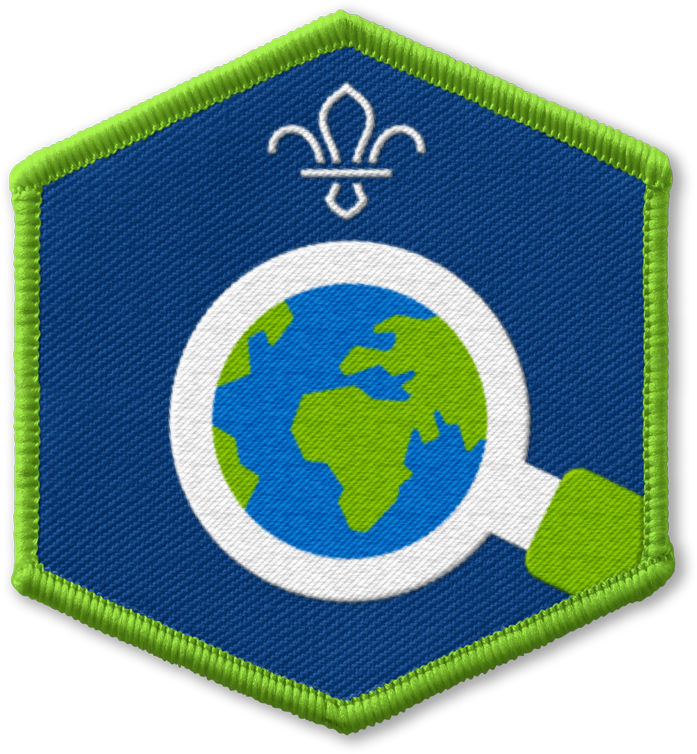
Welcome welcome
You’ll need
- Scout badges (or pictures of Scout badges)
Before you begin
- Ask one or two people from another section in Scouts to come and be guest speakers. Help them decide what they’d like to do – they could just chat about their experiences in Scouts or they could lead a game or an activity for everyone to try.
- Bring some badges (or pictures of badges) from different Scout sections to the meeting. You could ask your guests to bring some badges along with them too.
Story time
- Everyone should sit in a circle.
- Someone should read A Very Welcome Visitor by Jess Connett. Make sure you pick up a copy of the story before the session.
- After reading the story, everyone should take some time to reflect on it as a group. We’ve included some questions to help you reflect in the pink box below.
‘Lottie, I have an important job for you,’ said Lottie’s mother.
‘Your Aunt Lena, Uncle Paul, and cousin Ingrid are going to visit from Germany.
‘Ingrid hasn’t visited before, and she’s feeling a bit nervous. I want you to think of some ways to make her feel welcome.’
Lottie felt proud to have been given an important job. But how could she make her cousin feel welcome?
Lottie went to find her father. He was sorting the laundry. ‘Father, what can you do to make someone feel welcome?’ she asked.
‘Well, you could find out something you have in common,’ said Lottie’s father. ‘If you both have a favourite toy, or you both like the same game, then you could play together.’
‘That’s a good idea,’ said Lottie. ‘I’ll find out what Ingrid likes to do best.’
She skipped off to find Elias, her older brother. He was fixing his bicycle.
‘Elias, what can you do to make someone feel welcome?’ she asked.
‘When my friend Dan started school, he didn’t know anyone,’ said Elias. ‘His family had just moved to the area. I told him everyone’s names to help him get to know our class.’
‘That’s a good idea,’ said Lottie. ‘I’ll tell Ingrid everyone’s name when she arrives.’
Lottie’s mother had driven to the airport to pick everyone up. It was a long drive, but they arrived just in time for tea.
Lottie was very excited when she heard the car outside. She ran out, holding a nice drawing. She had made it for Ingrid, to make her feel welcome.
The two families said hello to each other, and Lottie gave Ingrid the picture. Then she told Ingrid the names of everyone in her family, including the cat and the dog!
Everyone went in to eat some tea together. Lottie sat next to Ingrid. She noticed Ingrid had a teddy with her, and she was feeding it a bit of her sandwich.
‘Do you like teddies?’ Lottie asked Ingrid. Her cousin nodded.
‘I like teddies too! Your teddy must be tired after that long journey. After tea, shall we go to my room and play with our teddies?’
Ingrid nodded. ‘I would like that,’ she said. ‘Thank you for making me feel welcome, Lottie.’
By Jess Connett
Brilliant badges
- Everyone should sit on the floor and take it in turns to introduce themselves by saying their name and a fact about themselves.
- Everyone should then split into small groups and talk to the other people in their group about what they think a Scout does and what qualities a Scout has.
- The person leading the activity should give each group some badges from other sections in Scouts. Each group should talk about why these badges might be given to a Scout.
- Everyone should get back into a large circle on the floor and take it in turns to feed back to the group. What did they chat about?
- The person leading the activity should hold up a badge and describe it. Anyone who thinks they know what the badge is for should stand up.
- The person leading the activity should ask someone who’s standing up what they think the badge is for. If they get it right (or they’re really close), then they win a point.
- Everyone should repeat steps five and six to keep playing until they’ve seen all of the badges. The team with the most points is the winner.
Super Scouts
- Everyone should sit in a circle on the floor.
- The guest speakers should talk about their time in Scouts. What activities have they done in other sections? If they’ve been part of more than one section, did they notice that things were different when they moved?
- The guests speakers could run an activity or game that they’ve enjoyed.
- Everyone should put their hand up if they’d like to ask the guest speakers a question. The guest speakers should choose people to ask their questions one at a time.
Reflection
This activity encouraged everyone to explore the Scout programme, understand what it means to be a Scout, and think about the qualities a Scout needs to succeed. Hopefully the activities helped everyone see just how many opportunities there are in Scouts – as well as reminding them of some of the reasons it’s great to get stuck in.
You could talk about the reflection questions below throughout the sessions or at the end.
A Very Welcome Visitor
- How did Lottie help her cousin feel less nervous?
- Why is it important to let people feel welcome?
Brilliant badges
- Why do Scouts earn badges?
- How do Scouts show other people their badges? Why do they do this?
Super Scouts
- Why sorts of things make someone a great Scout?
- What are people excited about doing with Scouts?
Safety
All activities must be safely managed. You must complete a thorough risk assessment and take appropriate steps to reduce risk. Use the safety checklist to help you plan and risk assess your activity. Always get approval for the activity, and have suitable supervision and an InTouch process.
- People could play the guessing game in Brilliant badges individually, instead of in small groups.
- You could talk about what people would have to do to achieve each badge. Can anyone guess some of the requirements?
- If you can’t organise for guest speakers to visit, you could get parental consent to film older Scouts talking about all of the exciting things they’ve done and play the video for the group. You could even visit the older Scouts a second time or send their leader a message to pass on people’s questions.
Some people may struggle to see small badges when they’re sat in the circle – you could print pictures of the badges so that anyone who needs a paper copy can have one.
All Scout activities should be inclusive and accessible.
When people go home, they could share what they’ve learned about Scouts with the people they live with, family, and friends. Did they learn anything unexpected or exciting?
Encourage young people to ask the guest speakers questions, as well as talking to each other.
